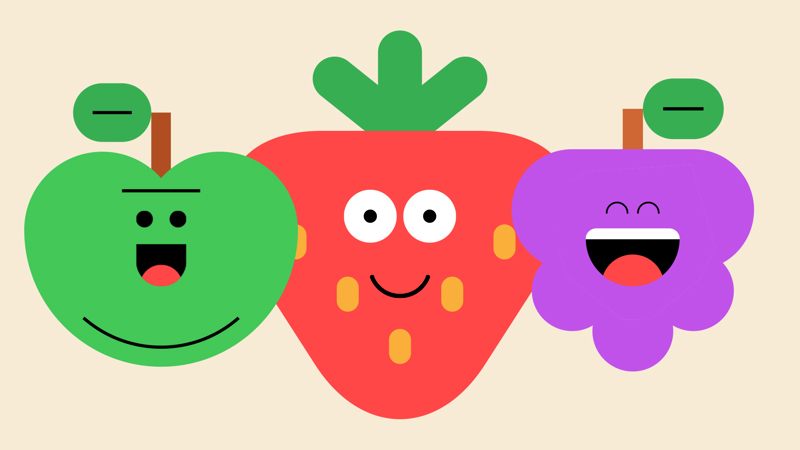
Play Fruit Salad
Before you begin
- Use the safety checklist to help you plan and risk assess your activity. Additional help to carry out your risk assessment, including examples can be found here. Don’t forget to make sure all young people and adults involved in the activity know how to take part safely.
- Make sure you’ll have enough adult helpers. You may need some parents and carers to help if you’re short on helpers.
Planning this activity
- This game works best if everyone has a marker to show were they were sat, such as a floor dot or cone. You could also use chairs in a circle facing outwards, so people can stand up and move easily.
Play fruit salad
- Ask everyone to sit in a circle. They should make sure that there’s enough space for people to run around the outside of the circle.
- Choose four different types of fruit. They should walk around the circle, tap people on the shoulder, and give them a fruit name. They should give the fruit names out in order, so every fourth person will be the same fruit.
- To make it easier to define the fruits, people could wear bibs, different coloured neckers or something else to define each group of fruits.
- Check that everyone knows what fruit they are. They could ask each fruit to put their hands up in turn, or could ask if anyone doesn’t remember their fruit. If anyone’s forgotten their fruit, you can work out what fruit they are, or just give them a new one.
- Now it’s good to have a practice round. They should call out the name of one of the fruits. Anyone with that fruit name should get up, run around the edge of the circle, and sit down in a different place to where they were before.
- Keep running practice rounds until they think everyone understands the rules and is ready to play.
- Keep calling out fruits, and everyone should keep getting up and running around the edge when their fruit name is called.
- If ’Fruit Salad’ is called, everyone should stand up, run around the edge, and sit in a different space to the one they were in before.
- Now, tell everyone you're going to call out two fruits. No-one can move until both fruits have been called out. After the second fruit has been called out, both teams can move. Whichever team of fruits is the first to have all its players sat down in a different seat, gets a point. The team with the most number of points, wins. Remind everyone they can’t stop someone sitting in a space. Make sure each team can go the same number of times - it might help to write down an order of play. Will each team help each other to find seats? You could also reward teamwork, kindness, good communication and sharing.
Alternative ways to play
There are some different elements you can add into this game to make it harder. Some ideas include:
- Make it competitive—the last person to find a seat could be ‘out’, then a chair can be removed. Think about whether the people playing will enjoy this, or whether it would make it less fun. How will make sure the ‘out’ players don’t get bored?
- You could make up a story, so rather than just saying fruits, you could include them in a story about going shopping, or making and eating a fruit salad. If anyone doesn’t run, they could be out.
- You could make it tricker, so by starting to say a fruit name and changing their mind, or ending up saying a different fruit. You could even call out fruits that aren’t in the game, or words that sound a bit like a fruit (for example, ‘great’ instead of ‘grape’).
- You could speed up or slow down the game. Will they give everyone lots of time to run around and sit down before they call the next fruit, call them one after another, or even set another fruit off before one has finished?
- You could call fruits in pairs.
- You could tell the fruits how to move each time they call their name, such as crawling, jumping, or tiptoeing. They’ll have to think about actions everyone can do without hurting themselves or taking too long.
Reflection
This game involved lots of listening. How did you find listening carefully? Did you find anything tricky? What was fun about the game?
This game also involved about observation. How easy was it to find the seats? Did people help you? Did you help others if you spotted an empty space?
At the end, this game was also about teamwork, as your fruit team had to race to be the first group to be sat down. Was it harder? How did you work together? How did you communicate? Did you support each other?
If you played any more alternative versions, how did that change the game?
Is there anything you’d change to make your own version of the game? What might make it harder or more fun or sillier?
Safety
All activities must be safely managed. You must complete a thorough risk assessment and take appropriate steps to reduce risk. Use the safety checklist to help you plan and risk assess your activity. Always get approval for the activity, and have suitable supervision and an InTouch process.
- Active games
The game area should be free of hazards. Explain the rules of the game clearly and have a clear way to communicate that the game must stop when needed. Take a look at our guidance on running active games safely.
- You don’t have to make the game competitive—you can ask (or tell) the game leader not to introduce anything that makes it competitive if competitive games don’t work for all of the players.
- Make sure any actions are things everyone can do.
- The game leader doesn’t have to tap people on the shoulder to name them. Make sure they know if anyone doesn’t like to be touched.
All Scout activities should be inclusive and accessible.
Young people could also choose their own version—it doesn’t have to use different fruits. Maybe they want to turn the game into vegetable soup, colours of the rainbow, or a seasonal theme, such as Halloween?




